In Japan, summer is the time for horror movie releases. Here in America, it seems to be all about Halloween, because people want to go get scared then. We Japanese prefer to get frightened in summer. One would think crowding around a bunch of people in a theatre to stare ahead at a screen for a few hours might leave you packed in like sardines, what with all the body heat generated by everybody, but movie theatres are notorious for being ice-cold when you visit them, right? On the contrary, we flock to the summer horror releases because it's thought that becoming afraid at the movies will send chills up your spine, and chills naturally cool the body. Regardless, summer has been thought of as horror movie season in Japan for over half a century, and telling scary stories in summer time has been going on for over a thousand years.
But you know me, what do I get out of reviewing horror movies? I know if I desecrate a shrine I'm cursed until my inevitable horrific death, I know that if I fall in love with a woman who smiles a little too wide and stares at me hatefully when I turn my back that I'm cursed until my inevitable horrific death, and I know that if I watch a terrible movie and take it lightly, I'll be cursed into my inevitable horrific death. But that won't stop me from trying! My point is, I get it, horror movies, and you're popular enough that everybody has reviewed you by now, so I can't just be like everybody else and go "I wasn't really scared at this part but I find the nuances of Megan Fox's performance in Jennifer's Body just absolutely delightful". That's not me.
So I've selected this trashy, stupid, unintentionally comedic, low-budget, not-even-scary-to-easily-frightened-children movies to review. Sure it was meant to be scary, but somewhere along the way (often at every stop along the way) the ball was dropped, destroyed, and forgotten entirely. They're frightening, but not "Sadako coming through your screen in order to enact the Ju-On curse and drive insane that super hot girl from Audition who will torture you until you're nothing more than a pile of mangled body parts floating around in Dark Water" scary. No, this is scary for much different, much more hilarious reasons. Reasons such as:
Who in the hell thought this was a good idea and wanted to be attached to this project?
Why in the world would that ever happen?
Why didn't the editor attempt to fix that? At all?
Did they seriously think that this would scare anybody?
Today's movie is a traditional Japanese horror film. Traditional in the manner of, "churned out at little to no expense in a thinly-veiled attempt to cash in on the earlier success of Ring". However, you can also take it as that other meaning of traditional, a story based on a horrific and "possibly real and factual" curse from Shinto rituals that have gone horribly awry, in the manner of many popular folktales, video games and novels from Japan's storied and frightening past. But then churned out at little to no expense in a thinly-veiled attempt to cash in on the earlier success of Ring.
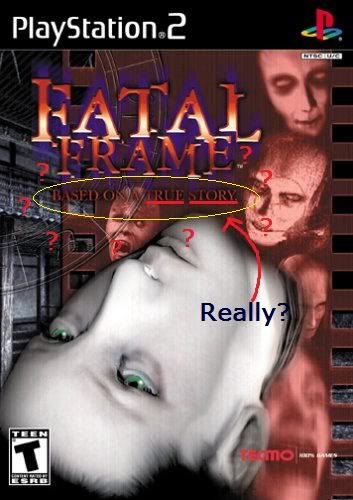
Of course, I didn't know this at the time. In fact, I didn't know anything, because I didn't buy it. Let me take you back to a simpler time, a time before Netflix, a time before One Missed Call and The Grudge both had five sequels and prequels that I wasn't even vaguely aware of, a time when there was still a movie rental store near my house by the name of Hollywood Video. I would go there often to rent something or other, since the game store was conveniently attached to it, and my friends and I could get cheap-o horrible made-for-TV-movies and junk to watch without having to be stuck with the stigma of actually purchasing them. Also, they had the best brand of microwave popcorn. I miss it.
But I'm getting off track. My point is that I and sometimes my friends and or mother would all come in to get a quick rental. They had a huge selection, and I cannot recall them ever being "out" of something I wanted to rent. So eventually Blockbuster monopolized everything and Hollywood Video had to close. They had shipped back all of the films that they could, but those that remained were being given away at prices slashed more than the wrists of a Twilight fan. I immediately began scanning the shelves for some DVD I might have sort of enjoyed that I could now purchase for two dollars, and my mother milled the aisles in search of some old movie she'd rented once in hopes they still had it to save on those pesky jacked-up import fees. It turns out that they'd had to send this movie back, but what they did still have was one movie she had commented on Every. Single. Time. she had ever visited the video store. That movie?
Shikoku.

It looks scary, right? That sort of imagery is created to strike at the very core of your being and warn you that here be pretty girls in pretty kimono following ugly tradition and wreaking havoc on your life, your village, and your eternity. It looks like all of those other scary things that keep you awake at night. It just seemed to be of a better class than most of those other "JHorror" DVDs who couldn't even afford a slipcover in colour. Also, my mother had managed to locate the presence of some paper decorations used exclusively in Shinto, which must mean that this film had a better understanding of what we would find frightening, and was certainly worth the five dollars they were asking for in exchange.
It wasn't.
OK, it was, but not for the high and well-intentioned hopes she had placed upon it.
I remember having a passing thought that perhaps if this movie was so scary and associated with Shinto like the many other forms of media she collected and obsessed over and perhaps should have mentioned at one point, why hadn't she heard of it? Why hadn't anyone heard of it? (This will become a recurring pattern in my selection of these "horror" films.) But the level of excitement on her face and the whiteness of her knuckles as she gripped the case and held it protectively to her chest sent the thought fleeing straight out of my mind as quickly as it had come. She was buying me a lot of stuff, who was I to judge?
Anyway, I'm going to judge it now.
Movie Review - 死国 - Shikoku
So first of all, there are some disturbing problems on the DVD cover alone. This can easily be fixed since the slip is reversible, but ignoring it doesn't make it go away. First up, take a look at that title there. "Shikoku". Some of you may be saying, "Oh yes, one of the main islands of Japan, that's interesting." No. No it is not. That would be 四国 (Shikoku). And while this movie takes place in 四国 (Shikoku), which means "four lands", here we have a little play on words replacing shi 四, four, with the kanji shi 死, death. The number four in Japan (and several other Asian countries), is like the number 13 in the West, the "unlucky number", and this is the reason why, since "four" is pronounced the same as "death". Therefore giving four of anything is bad, the fourth room or level of a building will often be skipped, etc. Why am I going into all of this? Because this is basic knowledge and kind of a desperate attempt at easy fear. In case you didn't already know, puns make up most elements of Japanese humour. Puns and word play often involving no more than substituting one kanji for another. So now the title of the movie is "Land of Death". But it still takes place on the island of Shikoku, which you'll recall is not spelled that way at all. Right off the bat, this is, literally and figuratively, a bad sign.
Secondly, the back of the English DVD features this gem of a review.
"...taps into some of the same creepiness as the recent Japanese hit, Ringu."
But only some of the creepiness. That was the best review they could find? Not some dude on the street saying "Hey, if you watched Ringoo and aren't really sure which country it was from, or you enjoyed the American film The Ring and are the type of person to be entertained by anything vaguely resembling that, like the American remakes of One Missed Call and that whole Tale of Two Sisters Uninvited debacle, well... there's this one!" But I guess that's basically what they were saying anyway. So, this movie was obviously brought over quickly to cash in on the recent fame of JHorror at the time, right? So why not just say "...vaguely taps into some of the same elements as being from the same country as the original story that The Ring was based on."?
Which brings me to the worst problem with the cover of all. That girl there in the kimono? Kuriyama Chiaki.
Wait, hang on a second.
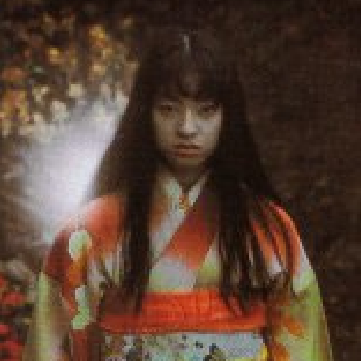
No, that's her. Huh. Oh well.
So this movie wasn't even brought over for that. It was quickly sent over in a failed attempt to cash in on the recent popularity of Kuriyama Chiaki, aka Gogo Yubari from Kill Bill, aka several Americans' first experience with a Japanese schoolgirl who doesn't really do much and, without any other resources to discover more, depend on films like this to further their obsession with her. So how far back in her archives did they go to find this cinematic masterpiece? Is was her very first starring role? Crap.
Here's the deal. I am in no way ashamed to admit that I am terribly attracted to Chiaki. But I will say that her acting skills could definitely use work. And if the tour de force that was Gogo Yubari staring blankly at things for a while and then dying was a later role for her after the slight success she was beginning to receive in Japan at the time after playing a character known to American audiences as "Girl #13", I knew that "her very first lead role" was not going to make her a major contender for my coveted "actress who can act" award.
So already, my expectations for this film were not high. But let's get started, anyway.
As it begins, the screen dark, we hear the haunting peals of the ritual staff, a rod with rings on it which makes a bell-like sound. Associated with Buddhism, these shakujou are carried by priests who hit them lightly along the ground to sound the rings fixed on top, which is said to alert other people of their presence, or to drive away animals, spirits or anything nearby that would cause harm. Since many elements of Buddhism were adopted into Shintoism when it was introduced, these staffs also are thought to not only drive out things with ill-intent, but to cleanse the entire area as well, an important aspect of the religion. They have also been adopted into the folk and mountain sects of Shinto, and these staffs are important implements used in the rituals, with the priests tapping them on the ground in unison, and are used for rituals involving exorcism.
The priests then appear, walking down the shrine steps carrying their staffs. I tell you all of this because this imagery and sound is very closely associated with many of the aforementioned terrifying Shinto-based folktales, and it is ingrained in me, from these things I've been told since childhood, to be prepared to be afraid when these things are presented to me. If I know that I'm about to view something that is going to be "scary", and that sound is anywhere in the vicinity I will automatically take it seriously. So, knowing that this film would be about the so-called "illegal" and gruesome mountain Shinto rituals now taking place in Shikoku with the "death" kanji, I, like an idiot, fell for it just the way they had planned, and was prepared to be enthralled and even a little frightened for a while.
It had that opening of the movie, camera whirling around in the woods at evening shot that all cheap horror movies made after The Blair Witch Project have, but I was still prepared to eat my words and feel the chills up my spine to help me escape from the overpowering heat of my home.
The priests climb a mountain and prepare their ritual, chanting. In a home down in the village, a priestess burns prayer sticks while she binds a young miko's limbs with ropes. The ropes make a terrible straining sound, again striking at the very core of terrible rituals that end in murder and horror and good stories. Acting as a medium, she chants faster and faster, summoning the spirit of a deceased boy to inhabit the miko and speak with his parents, who are sitting nearby watching the priestess' ritual with fear and hope. A few good effects happen here with the wind rustling their implements, the spirit coming into the room and seeing his parents before entering in the miko through her mouth, and the priestess woman being convincing enough as she moans to guide the spirit, the young girl thrashing about wildly.
The little girl speaks as the boy to the couple, and his voice echoes back around hers. The camera shows that the parents can see the actual child in place of the miko, and the title screen flashes as haunting music sputters around it.
So that's that. Spooky enough to even be unsettling while it's still daylight, encapsulating all of the tried-and-true Shinto-style horror staples. It's nothing original, but it's well done. It's as if someone came up with this story and then forgot about it, and had absolutely nowhere to go from there, so just handed it off to new writers and told them to do whatever they wanted with it.
So now the real plot begins, and since there is no real plot to speak of, all the creepiness they'd worked to create dissipates in a matter of two seconds, it's all so contrived and predictable that, if I didn't know Kuriyama Chiaki was coming, I would stop watching right now. The miko, named Sayori, and her two friends, skip out of school to go play by the river. Sayori expresses her desire to leave the village and accomplish great things while stock acoustic guitar music plays. The music in this whole movie is just abhorrent; it sounds like that soft, under-the-radar background music they play on the morning news shows in China and Japan whenever they give you the weather forecast. Anyway, Sayori's creepy dad shows up and takes her home, despite her vehement protesting; her friend Hinako, obviously concerned over Sayori's desperation to not go home and get away from her father, follows her and comes to visit. No one answers the door, so she makes her way in and to the back, where the sounds of a ritual drum beat and a woman summoning the dead surprisingly do not disturb her or cause her to think twice about looking in the room at all.
As Sayori walks her out, she tells Hinako that she knows she saw her being used as a possession vessel by her mother, and to keep it a secret. Sayori gets a touch of the crazy eye and threatens Hinako, who promises not to tell anyone, even their other friend Fumiya, whom she has a crush on. We then see Hinako drowning in the river, and as Fumiya rushes for help, Sayori calmly wades in and drags her to safety. As help arrives, Hinako screams and cries for no one to touch her, holding tightly to Sayori and begging to stay with her, as Sayori stares off conspiratorially. Sayori is definitely the child version of Chiaki's character, I can tell.
I'd like to imagine that it's immediately after that scene, but Hinako and her family are moving away to Tokyo, and she and Sayori promise to keep in touch. Fumiya waves goodbye to her, watching her go, but Sayori is too busy glaring at this display to wave goodbye to Hinako as well. I wonder where this is going? Flash-forward 15 years later, and Hinako is hot, styled in her 80s Tokyo fashion best, and on her way back to Shikoku. Her mobile phone rings to let her further explain that she is going back to Shikoku and had been in Tokyo and is the older version of Hinako now, and crap any idiot would have deduced already, and all the old people riding the bus with her give her dirty looks for being dressed all urban and having modern technology and disturbing their naps.
Most urban legends in Japan, modern and ancient dating back to the ghost stories of Edo and Heian capital, usually have a focus on terrifying rituals and occurrences happening in haunted or backwoods country places, in the mountains, in near-abandoned seaside towns, and here in the off-the-mainland and barely populated country prefecture of Kochi in Shikoku. The reason is that these places were and remain in the collective conscious to be seen as wild, untamed, uncivilized and very different than what the majority of people who live in the capital are used to. So when someone starts a scary story in Japan, it will usually take place or be focused around some odd thing that happened or came from these removed and strange villages.

How primitive!
As the bus pulls into her hometown, the mobile she was talking on suddenly goes out of service, highlighting the fact that this city girl is now stranded in this isolated rural setting. Regardless, they still spend about ten minutes further enforcing it by having everybody act all hostile toward her and comment on how she's so modern and different now.
She looks in on her old house, where she immediately rushes back to pull up a porch plank that she had written Fumiya's name on to confess the crush to Sayori all those years ago. Reminiscing, she heads to Sayori's imposing traditional mansion near the top of the village. She knocks on the door and calls out, but no one answers. As she goes to leave, she sees someone looking down at her from an upstairs window. She then walks away, undoubtedly assuming her eyes were just picking up on some trick of the light.

Riiiiiiight.
So obviously, what this entire experience is needing to complete the urban legend effect is a creepy old town-centric festival. And of course they're having one today! It really is pretty frightening, with the performers doing a ritual dance wearing disturbing animal masks and costumes. It's reminiscent of the terrifying animal costume festival during the entire second half of the much scarier and better done film The Wicker Man. But unfortunately, here it all is pretty much happening in the background of the useless exposition of the plot of Shikoku. You see some interesting happenings going on for maybe two seconds behind Hinako's Concerned Face, and you think, hey, can we focus in on the festival a bit more?

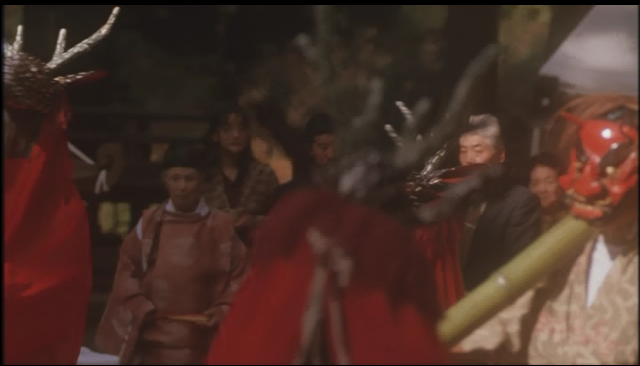
I want to see this story.
But alas, Hinako sees one of her old classmates, and she asks after Sayori. The classmate critically informs her that Sayori died years ago when she drowned in the river. The very same river she saved Hinako from. DUN DUN DUNNNN. Oh, so I guess we won't be seeing Chiaki in this movie after all.
Naturally, the next classmate Hinako encounters is Fumiya, and he is all grown up and just reeking with incompetence. They share a tender reunion for a moment, before making the obvious choice, not to catch up on old times, but to go down to the river and see where Sayori died. Hinako reminisces on how safe she felt being with Sayori, and Fumiya recounts the goings-on of the Hiura family: Sayori's father has been hospitalized since he fell off a mountain, and her mother has been making pilgrimages since her daughter's death, claiming that Sayori is accompanying her. Hinako mentions how she'd been wanting to see Sayori no less than eight times, I swear, in less than five minutes, and then stares off thoughtfully as she'd been doing since she arrived. She cheerfully explains to Fumiya that she feels Sayori watching them. They're both much too calm for the subject matter of their conversation. "Oh no, horrific deaths and misfortune and hauntings from the other side aren't anything odd, it's not like we'd get freaked out if you changed the character for 'four' into 'death' or anything, fancy some tea?"
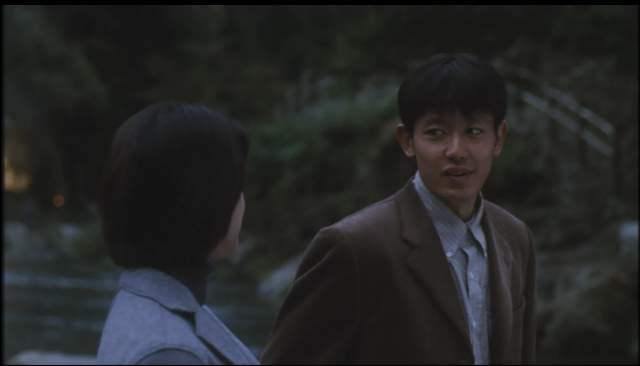
Back at the scant scary parts of the movie, Sayori's mother marches up the steps to a temple, exhausted and covered in filth from her incessant journeys, mumbling nonsensically to herself. She prays and gets her nokyocho book stamped before continuing on like a good pilgrim. But she glares meaningfully at the camera like a bad pilgrim.
Returning quickly to
Except we do, in what is becoming an annoying trend of having some quasi-threatening message stated, and then immediately restated with absolutely no room for doubt and killing off any creepy thriller feelings that might have been starting to build up by the very next scene, in case you missed it. The following conversation after the issue with the gate and the Jizo statues goes exactly like this:
"Oh, did you hear that the heads were cut off of the Jizo statues?"
"Humans should not interfere with things dealing with heaven."
"Did you hear about that broken gate?"
"Anybody who goes in that gate will be cursed."
Oh yeah, that's a natural-sounding exchange.
Later, at Hinako's home, Fumiya brings over a photograph of Sayori, which looks suspiciously like a photo of Kuriyama Chiaki cosplaying the World's Oldest Teenager.

I know she's 15 and still a teenager here, but since it's over a decade later and she still looks the exact same always, I stand by my statement.
Fumiya and Hinako share another awkward and inappropriate conversation about Sayori and how she's dead and how she had dreams but also was a priestess and now she's dead and can't do either. The thing that's bugging me now, is that the costume designer really went overboard in their characterization attempt. Despite several outfit changes, Hinako is constantly wearing "sleek and stylish shades of city grey" and Fumiya is always dull as mustard with the clothes to match. He's worn no less than four mustard-coloured vests and cardigans so far. I know it's supposed to make them seem contrasting in visual as well as lifestyle, and set off Sayori's mother's henro white, and undoubtedly that red kimono Chiaki's about to show up in, but it's just so boring and obvious that it really reinforces the fact that Hinako is a bland and terrible actress. Oh no, another ineffectually cute girl playing the lead damsel in distress, blah blah blah who cares.
That night, Sayori does the trite scary girl bit by suddenly being beside Hinako, watching as she sleeps.

I can tell it's Chiaki because of that wig. That's Chiaki's wig.
Hinako hears the sound of a backpack charm jingling and wakes up, sensing someone's presence.

Wow, this shot... taps into some of the same creepiness as the recent Japanese hit, Ringu.
Of course, Hinako decides to show up while he is at work to inform him that she thought she saw the ghost of his dead girlfriend. She really doesn't want to salvage any kind of a relationship with him at all, does she? If I returned to the village of my birth and saw a girl who was my friend when I was eight that I haven't seen for twenty years, I would definitely want to talk to her about all the horrible memories and rehash that pain that happened while I was gone and continue to dwell on them instead of letting it go as none of my business and allowing her to cope. I FEEL THAT SHE WOULD NEED TO KNOW.
Naturally, this means that Nosy Useless Lead Actress and Captain Excitement are on the case! Fumiya jumps on the crazy theory bandwagon by saying that Sayori hadn't really drowned, but had summoned a demon who spirited her away. I know the movie wasn't planning on this, but let's pause and analyze that idea for a second. Was Fumiya around when she died? Did he hear that she had drowned? Did everybody say this because they seemed to have recovered her water-filled corpse from the river? Did he attend her funeral? Why would he entertain that rumour for more than two seconds?
The answer is immediately obvious: Fumiya is insane. Because he then decides to test out that foolproof rope-off job he's just completed (which consisted of draping a single caution rope above the hole without actually covering it at all) by heading right through the gate.
At the end of the pathway is a stone pillar in the center of a pond, facing a cave opening. Oh, like the entrance to Hell? Really, movie? This is your sense of subtlety?
But it wouldn't be Shikoku without some pointless reinstatement, so some little kid kicks a soccer ball into a terrifying old man leering in a field. He then runs to tell his mother that he just saw his dead grandfather. WAIT, YOU MEAN BAD THINGS MIGHT HAPPEN IF PEOPLE GO PAST THAT CURSED GATE TO THE HELL-ENTRANCE? I DON'T UNDERSTAND!
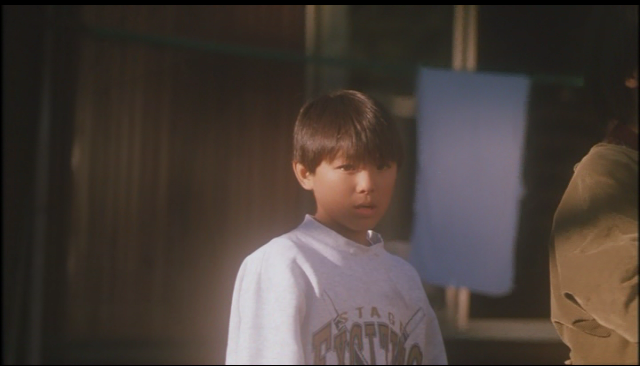
Continuing with the tour de force of horror clichés, Hinako visits the hospital where Sayori's comatose dad has been for the past eight years. She and the nurse stare terror-struck at an extremely obvious stain on the ceiling, then run from the room.

On the way back, Hinako's tactless former classmate gives an extended lecture of exposition which I will now sum up: She felt that Hinako was always hanging around Sayori like a servant, and since she got to leave and Sayori didn't, Sayori thought Hinako was a snob and burned all of the letters Hinako sent her, and Hinako shouldn't interact with people in town since she was a stranger from Tokyo now, and the Hiura family was bad news, and she seems like a slut for hanging out with Fumiya so much because Shikoku is not like Tokyo and is a very isolated and haunted scary scary insular place, so...
Unfortunately, I'm not a moon-faced leading actress, or you would see me telling that glasses-wearing bitch to pull the car over and shut up and mind her own business before somebody got cursed, and then heavily imply that that somebody would be her.
Then, Hinako and Fumiya have the same conversation about Sayori that just happened in the car. Except now Hinako decides that she shouldn't have come back since Sayori didn't really like her, and instead Sayori obviously would rather see Fumiya. Because ghosts have no control over who they haunt and, despite you being gone for almost twenty years and then suddenly coming back and having this girl appear to you, no, she was just trying to haunt that guy she grew up with who's been in the local office all that time. Obviously this was just some baseless ploy to get Fumiya to compliment her and say he liked her better than Sayori, which he reluctantly does.
Try to follow me here... the old man who runs the local office, Sakai, who lectured Fumiya about the curses and leaving heaven to heaven and not interfering, goes alone at night to further investigate the headless Jizo statues, sees the apparitions of dead people, goes into the office the next morning, collapses, and is rushed to the hospital. The little soccer-playing kid throws a rock through Hinako's window and accuses her of summoning ghosts. So with all of these peaceful goings-on, Fumiya brings a photographer named Oda in from out of town to take pictures of that Hell-entrance-looking-place behind the cursed gate. They touch the pillar, walk around in the surrounding pool, and comment how this thing they're standing in looks just like the entrance to Hell.
Oda deduces that the place is probably avoided since it looks like the Hell gateway, heads in, happens across a recently-used ritual area tied with sacred ropes and filled with many blessed piles of stones. Recall the entry on Jigoku, talking about Japanese Hell and Jizo and how the stones are important? They are stacked by grieving parents of children who have died before them in order to help them in the other world, and coincidentally we see that Sayori's mother has been collecting and purifying stones at each temple she visits. But that obviously doesn't hold bearing here, so Oda desecrates one of the stone piles and comments how this area belongs to the Hiura family, and how he once saw an announcement for a book on the history of Shikoku written by Sayori's father. We never see Oda again. What was the point of his character, again?
Fumiya heads to the library and finds the ad in one of the folklore books written by Oda himself. Suddenly all of the pieces fall together in his mind, and he meets with Hinako to share his findings. He asks her if she's familiar with a Shikoku Pilgrimage. Oh, you mean the Shikoku Pilgrimage, one of the most famous aspects of your island, which is noted by the treacherous excursion through the prefecture you are currently in since it is so deserted and hazardous and you might fall off a mountain or something, like Sayori's father did while her mother was venturing said pilgrimage? No, please do go on!
He does go on to literally break out a stick and draw in the sand like some country school lesson for Hinako, explaining that the pilgrimage consists of visiting each temple designated all around the island of Shikoku, of which there are 88. The journey is cyclical; you start at one temple of your choosing and head around the island to each subsequent on in a clockwise order. According to Sayori's father's folklore book, this journey is meant to seal and ward the island between the world of the living and the dead, and the pilgrims making this trek help to energize this plane separation and bless the island. Naturally, while he has his stick and an oblivious student, he explains that, should this circle be broken, the seal between the two worlds would be fractured, and the dead living on the other side would be able to freely enter Shikoku. But whyyyy? He draws the kanji for Shikoku and explains about the four and the death and the unluckiness and other filler for the uninformed and those unfamiliar with the fine art of kanji plays-on-words that run rampant through Japan like dead people in Shikoku.

Do you get it yet? Do you?
Seriously, this is like if Friday the 13th spent half the film explaining why Friday the 13th is unlucky. We get it, we get it, now let's see Jason cut some people!
Despite growing up in Tokyo and being unaware that 'death' sounds like 'four', Hinako somehow knows that Sayori's mother is doing the pilgrimage, they need to find a copy of her father's book, and that the 15 piles of stones in the ritual area might have something to do with the strange number 16 she saw stained in his hospital room. Fumiya notes that Sayori was 16 year old when she died. I'll just go ahead and note that 16 is four times four. Nobody else notes this. Moving on.

They wait until nightfall, and go break into the Hirua mansion. From this point in the movie onward, Hinako has taken to wearing red with her usual gray. I'm sure this has nothing to do with the terrible mistakes she's about to make, incurring the wrath of the dead. In Sayori's room, they see a doll and stare at it for about thirty seconds (to give people enough time to mark their cards for Traditional Japanese Horror Gimmick Bingo), and rifle through her things, where Hinako finds some cards and gifts from Fumiya and realises that they had dated. In the Ritual Room, they find the seals from all of the shrines hanging on the walls, filling the place. Fifteen of the sliding doors are covered, one left blank. Prayer stakes and a funereal photograph of Chiaki are enshrined at the head of the room, situated in between the ropes and drum she used to sit in front of when summoning the dead. As they go to leave, a sliding door falls over on them, and as they pick it up they notice that Sayori's mother is making the pilgrimage backwards, and is now on her sixteenth cycle, which is four times four and the age Sayori was when she died and is breaking the seal between the world of the living and the dead where her effigy is waiting in the seat where the dead are summoned. The slips flutter as they stand there staring blankly and apparently reaching no conclusion.
They go back to Hinako's house, where she confronts him about dating Sayori. He confesses that Sayori always watched over him, when they were friends, when they dated, and now that she's dead, she still watches and follows him and is always in his mind. He says that Sayori loved him so deeply and intensely that he could never love another girl after her, since no other girl loved him in that way. Not even Hinako, whom Sayori hated, whom she was jealous of and angry that she liked Fumiya too and now has returned to Shikoku and is being watched constantly by Sayori as her spirit stays with Fumiya while she comes ever-closer to the dissipating barrier between the world of the living and the dead. That Sayori.
Let's play a little game. What is the worst possible thing that would happen to further incite the anger of the dead and the vengeful, specifically something that would desecrate a holy place or memory, of which Sayori is all of the above?
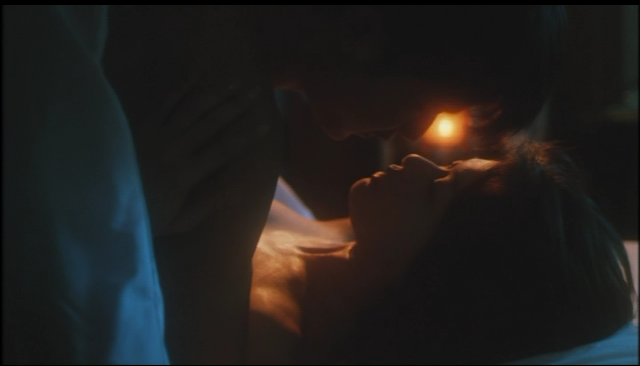
If you said "swear to forget all memory of her and have sex with each other", you lose, because this movie is terrible.
Back at the Ritual Room, the slips begin to fly and the Chiaki picture looks angry. Fumiya puts one of his mustard vests back on and decides that, instead of showering or sleeping or attempting anything to further purify himself and repent for his bad decisions, to read the ancient ritual book Sayori's father wrote. Sayori appears behind him and rests her hand on his shoulder. TRADITIONAL JAPANESE HORROR GIMMICK BINGO! Five in a row, diagonally, I win!
Fumiya thinks she's Hinako and explains that he's discovered that the Hell Mouth Entrance thing is also the Hiura Shrine, where the women of the family are deified and receive supernatural powers.
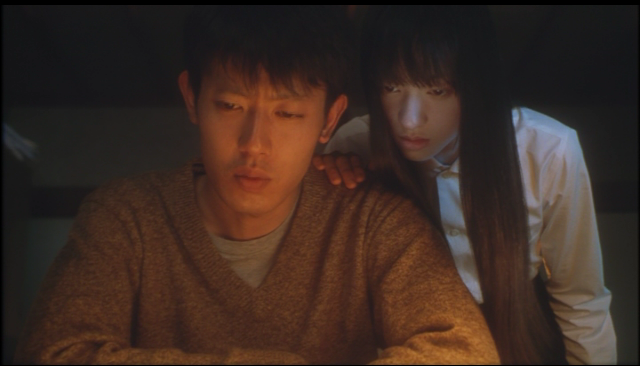
Fascinating.
Hinako comes in with some tea and is shocked to find her new boyfriend with another woman. Who is his ex-girlfriend. And is sixteen years old. And dead. He looks around, but Sayori is gone. Hinako tries to go to him, but Sayori grabs her.
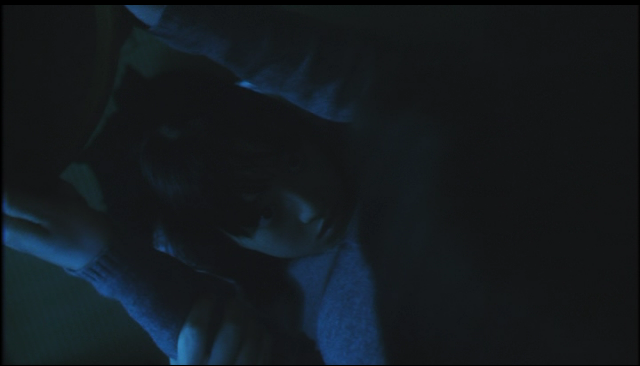

No, it's OK, I'll just clear off my bingo board, we can play again.
Hinako drops the tea tray and knocks Sayori to the ground. Sayori glares at the couple and disappears. Hinako begins to sob, recalling that look as the same one Sayori had on her face when she pushed her into the river as a child and tried to drown Hinako. Wait, she tried to drown her? Then what was that whole spiel of feeling safe in her arms? That makes no sense! She has a mini mental breakdown and starts hyperventilating, causing Fumiya to slap her back to reality. A bit harder than was necessary, really, but I don't blame him; she's annoying. Seriously, this must be the worst night of his life. Can't even get a little action from a dumb girl without the ex showing up being all haunted and ruining the mood.
Fumiya and Hinako visit a folklorist the next day, who explains to them that, in an ancient ritual, the priestess will circle the stone pillar at the Hell Entrance clockwise to seal the realm. Going counter-clockwise will unseal it. Sayori's mother is going counter-clockwise around the shrines, unsealing the plane and summoning the dead with the intention of bringing her daughter Sayori back to life, whom Fumiya and Hinako saw the ghost of the night before, since her mother is almost finished with the ritual. Fumiya tells Hinako that he no longer cares for Sayori now that Hinako slept with him, and rips up the picture of Sayori he keeps in his wallet. Sayori, the vengeful girl on the way back from the dead. I'm quickly running out of benefits of the doubt to defend them with. Well, at least they didn't... no, they already did that. That too. And that one they did in the Ritual Room. Oh, and the angry ghost was present for that time. Nope, they're screwed.
The folklorist, who had dismissed them in a rage since they were being sacrilegious and talking about unsealing the rite, senses this too and gives them the name of someone who can help, the leader of a group of priests who work to complete the pilgrimage and seal the island constantly. They live atop the mountain Sayori's father was climbing when he fell off and went into a coma.
Speaking of him, his crazy wife visits him in the hospital and tells him she's finished the reverse pilgrimage ritual. She gleefully exclaims that she is victorious over him, and that Sayori will come back and continue to be a Hiura priestess against his wishes. He grabs her, but unfortunately that weird stain on the ceiling has morphed into the shape of the island of Shikoku, so his wife takes even more joy that all is lost.
The priest Fumiya and Hinako visit explains that the summit of the mountain is where people of Shikoku who have died will ascend to go to the next world. Vengeful spirits who are too strongly attached to unfinished business in their lives linger near the Hell Entrance instead of ascending, in hopes that the seal will be broken so that they may pass through and take human form once more in the world of the living. He explains that it won't just be Sayori coming back, but all dead spirits, and her mother must be stopped from completing the ritual at all costs.
Back at the village, Sayori's mother has completed the ritual, her father dies, and the priest's fervent back-pedaling of purification and reinstating the seal is for naught.
Kuriyama Chiaki comes out of the holy pool naked and covered in lime Jello, two of my favorite things.

Her mother washes her off and confesses that she pushed Sayori's father off of the mountain since he tried to interfere in her plan to keep the Hiura line going. She dresses Sayori in her priestess garb and brings her back to their mansion, doing a spirit-summoning ritual once again (They ran out of rituals to do already? But there are like billions!), this time summoning Sayori's spirit back into her body.
Sayori snaps back into existence, but only sort of, because... well... Chiaki's acting in this is laughably bad. Not even laughably. I am honestly embarrassed watching her, it's that bad. I am uncomfortable, for her just as much as for me watching it. She makes an excellent model. But this being her first starring role... well, you can really tell that she is an excellent model and nothing else. Let's just say the blank staring in Kill Bill is a vast, vast improvement.
The first thing Sayori thinks of is Fumiya, and her mother vigorously agrees to go find him and bring him there at once so that he and Sayori can immediately continue the Hirua line, since Sayori must have a girl baby to receive the spiritual powers as well. Sayori recalls that she hates the Hirua line and being a priestess and that she only wants to see Fumiya and leave Shikoku. Her mother embraces her, and she kind of hugs back, which for some reason breaks her mother's spine and kills her. Ghosts are super strong for no reason, I guess? Also pretty unaware, because Sayori calls weakly for her mother and then just goes to sleep. Fuck, I am sorry, every line from this girl is just hard to watch, look.
Fumiya and Hinako show up too late and look around, but don't actually go in to check it out or anything. Fumiya tells Hinako to wait alone in case the psychotic dead-summoning priestess comes back with her beyond-the-grave daughter, while he goes to check out the Hell Entrance. Safety in numbers, people. I guess Chiaki acts her way out of the Ritual Room to the front room in order to flip on a light, and Hinako heads in to investigate. She finds Chiaki dragging herself down the dark hallway in what should be a terrifying scene, but honestly, I'm bored and could care less. There's no tense music, no creepy sound effects... I guess they broke the budget on that snap-crackle-pop spine thingy that they never explain.
I once again recall the Fatal Frame series, which includes no less than four hundred "Evil Priestess Appears At the End of Hallway and Limps Toward You" scenes, and it was frightening as hell, every time. In a game filled with progressively more-gruesome ghosts and lots of things jumping around to freak you out for hours since it's a video game, every time that spot hit, you'd lose your cool and attempt to run away in any way possible, be it frantically pressing buttons, getting stuck in between a door and some random ritual implement, or just flinging the controller at the TV and heading for the hills physically. So here, at the climax of the movie where Sayori stumbles down the hallway in physical form towards her mortal foe, who previously had nightmares and dropped tea every time she thought she heard her someplace, now she just kind of stands there, like she's thinking, "Uhh... do you need me to help you get down the steps?"
Sayori finally bumbles into Hinako and tells her that she wants Fumiya, and Hinako gets all teary-eyed and flees from the house like a jealous lover. Not a woman who has just seen her childhood friend reanimated with the help of a grisly religious ritual. Stupid. She runs at top speed down to Fumiya, who sees Sayori standing just behind her. Despite the fact that Hinako ran as fast as she could and Sayori can barely walk in the first place. Fumiya gazes lustfully at Sayori, but says they cannot be together, because she's a 16 year old undead priestess and he's a 28 year old nitwit, obviously, but Hinako takes it as a testament of his faithfulness to her, and grabs him possessively.
Sayori goes into a diatribe to Hinako's idiocy, how she would always tag along to Sayori in hopes to be as interesting and/or attractive as she is, and that Fumiya only feels sorry for her, and her love for him is foolish and useless since he really only cares for Sayori and wants to leave Shikoku with her, anyway. He does, and wrenches his hand away from Hinako to go to Sayori and kisses her.

They embrace, and... she crushes his spine and he dies and she gets confused again. I just don't get it. It's not scary, it makes no sense since she doesn't seem to want to kill anybody, despite having about a million valid reasons to. She has no motive, so she's not even threatening. She's just... there. Like a model modelling in a movie instead of acting. She tries her darndest, though, and she gives this amazingly half-assed wail, like, "WUUUUUHHHHHHHH!!!!"
She then decides that this is all Hinako's fault, which it very may well be, and hackneyed lightning strikes behind her as she looms towards Hinako and walks through the holy pool to her. Hinako just stands there feeling no one way or the other about her new boyfriend dumping her for some hot jailbait zombie, and so I guess the movie just ends with Sayori giving her the Hug O'Doom and we're done with it.
But no! Awesome Priest Guy, who came in at the 11th hour and still has been the only person to actively try to do anything in this movie, has arrived with every exorcism implement he could carry and begins to drive Sayori away. Sayori flies through the air and becomes a demon, impaling him in the neck with a horn, causing him to burst into flames. Wait no, she starts crying and whining that a person's love doesn't die just because they do, and wonders what right he has to say she can't be alive. Well, you were a horrible person and brought back to life by an insane woman through a taboo ritual that directly affronts him as a priest and endangers his religion as well as the people of the world since the rest of the malicious spirits have re-entered it too, but no, you really needed to come back to be with your boyfriend. Who you killed. Unwittingly. For no reason.
Sayori turns to Hinako now, and laments that she had so much she wanted to do with her life, and to be with Fumiya, and that she was so jealous that Hinako got to leave and go to Tokyo since Hinako is basically a waste of life who doesn't even know what she wants to do or where she's going and is unjustly being allowed to live without appreciating it, while Sayori had to die. But wait, how did Sayori die? Because I don't believe the whole demon theory at all, I just figured she killed herself by jumping into the river. I assume that at this point in the movie, all the original writers had left and nobody really knew what they were doing anyway, because I am looking, but I'm not finding a plot right now. So I guess... we're supposed to empathise Sayori? Is she the main heroine here?
Hinako stands there being completely useless, and the priest just beats Sayori upside the head with his staff and carries her off to go send her to the other side. He tosses her back into the pool from whence she came, and attempts to knock over the stone piles to seal the ritual off and bind her there. She jumps out of the pool and tries to stop him, but he easily kicks her away and she dog paddles to stay afloat, and they didn't even play SURPRISE! music or anything. Hinako borings herself in and the priest commands her to scatter the piles of stones, but instead she just says "No", and tries to pull Sayori back out. Why? For what? So she can be hugged to death and all the world can be a walking hell because she feels bad about not being a good enough friend to this girl who hates her?
At the crucial moment, Fumiya busts in out of nowhere and goes into the pool with Sayori, who accepts this as good enough, and they both sink into the pool and disappear. The priest dismantles the stone piles while Hinako cries and tells him to stop, but he says that Fumiya and Sayori will now go to the other side, and Hinako is free to continue living her useless life. Seriously, every movie these days has this bland leading girl who is pretty but does nothing and is just the paramount of kindness and doing nothing one way or another so as not to cause waves and is basically devoid of character so she can serve as a place-holder for the audience, like, "This is what it would be like if this film was a play and you were standing here doing nothing and watching the goings-on". I like to call this "The Bella Swan Effect". Sorry, Hinako, I see you there preparing to head back to Tokyo and praying at the holy mountain for the souls of your friends who didn't really like you that much, but honestly, what was there to like?

Wait, what?
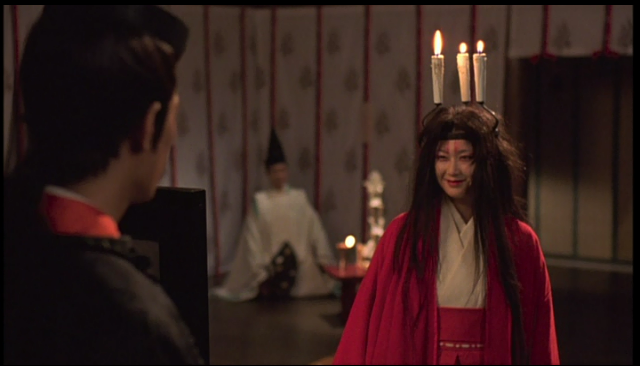
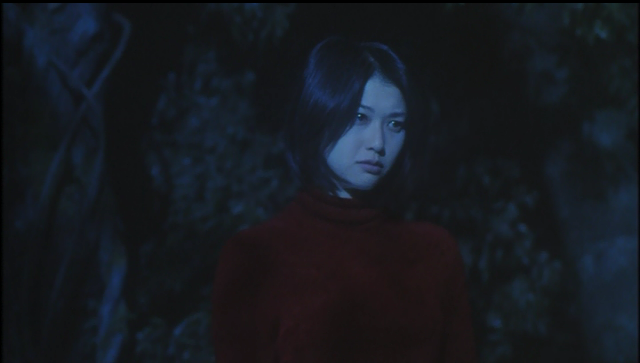
Hold on. So you're telling me that the girl playing Hinako in this awful movie, Natsukawa Yui, also played one of the best and most frightening versions of a namanari demon lady ever seen in film, Fujiwara no Sukehime in Onmyoji? And that we could have had her bringing life and purpose into the popular vengeful evil priestess character, but instead we had Kuriyama Chiaki in a little star vehicle crashing into the wall as Yui did the best job of playing a convincing leading heroine whose characterization she saw as without purpose, just like all the other useless characters and nonsensical plot points in this stupid, stupid film? Fuck this movie, I'm done.
It really could have been so good. They had the tools, and at least three good actors (Yui and that priest dude and Osugi Ren being wasted in a bit part as Sayori's creepy dad), but the whole thing was a muddled mess of romantic storyline getting tangled up in what should be the main plot, any type of horror or creepiness. Instead, they teased us with things that could potentially be creepy, but then eventually forgot about them or just gave up altogether. It seems like it would be the American remake of a Japanese film based on a better book or game or legend. The plot is just confusing and lost, like it didn't translate well to someone, like I imagine all the Pulses and Shutters and Uninviteds and Grudges to be. But even though it seemed like something had been left out and many things were needlessly explained and rehashed over and over so as to bring you into the realm of the film from a foreign place, the fact is that it was unnecessarily bad for no reason. I guess it really was trying to cash in on the new interest in Japanese horror brought on by Ring, but trying to set itself apart by following a more traditional style of Japanese horror, but unfortunately it didn't seem to know enough traditional Japanese horror stories or want to stray too far from the path of slow-boil Ring-style horror, which doesn't fit or make sense in a movie like this. Every cliché in the book was present, without an overlying plot, and I can't stress how many really great directions could have been gone after by choosing any one of the endless Mountain Ritual Cult stories. There just wasn't any story going on here at all.
I know an otaku guy who loves Kuriyama Chiaki so much that he literally burst into tears at the sight of that 2 second shot of her being dead in the credits at the end of Kill Bill Vol.2, and I think he would be bored by this movie. So who in the world would want to see this? My mother, that's who. She bought it and she watches it regularly, and she came in at times when she saw this on and I was typing terrible things about it and she seemed so so happy. So there you go, movie, the only person in the whole world who likes you is someone who devoutly collects things that resemble your cover and probably only cares for you out of principle.
And as for me? I think I'm gonna go lie down for a little while.
No comments:
Post a Comment